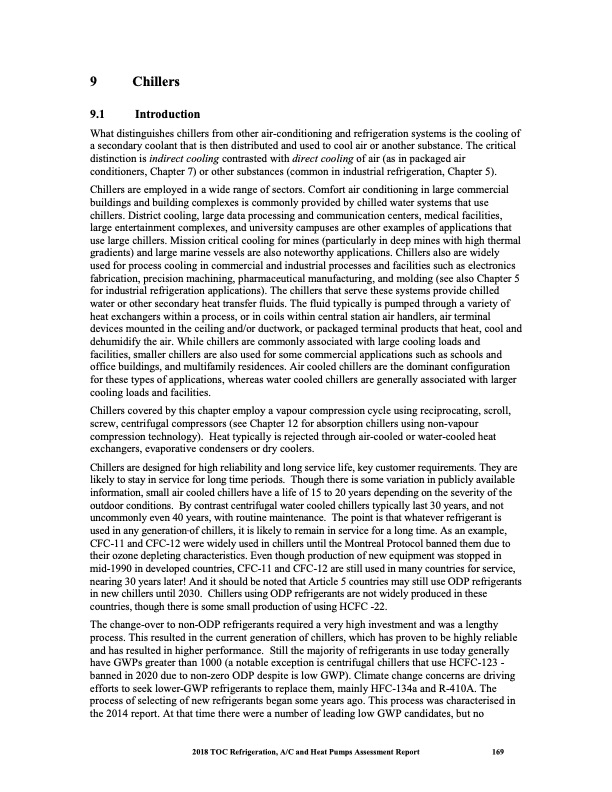
PDF Publication Title:
Text from PDF Page: 182
9 Chillers 9.1 Introduction What distinguishes chillers from other air-conditioning and refrigeration systems is the cooling of a secondary coolant that is then distributed and used to cool air or another substance. The critical distinction is indirect cooling contrasted with direct cooling of air (as in packaged air conditioners, Chapter 7) or other substances (common in industrial refrigeration, Chapter 5). Chillers are employed in a wide range of sectors. Comfort air conditioning in large commercial buildings and building complexes is commonly provided by chilled water systems that use chillers. District cooling, large data processing and communication centers, medical facilities, large entertainment complexes, and university campuses are other examples of applications that use large chillers. Mission critical cooling for mines (particularly in deep mines with high thermal gradients) and large marine vessels are also noteworthy applications. Chillers also are widely used for process cooling in commercial and industrial processes and facilities such as electronics fabrication, precision machining, pharmaceutical manufacturing, and molding (see also Chapter 5 for industrial refrigeration applications). The chillers that serve these systems provide chilled water or other secondary heat transfer fluids. The fluid typically is pumped through a variety of heat exchangers within a process, or in coils within central station air handlers, air terminal devices mounted in the ceiling and/or ductwork, or packaged terminal products that heat, cool and dehumidify the air. While chillers are commonly associated with large cooling loads and facilities, smaller chillers are also used for some commercial applications such as schools and office buildings, and multifamily residences. Air cooled chillers are the dominant configuration for these types of applications, whereas water cooled chillers are generally associated with larger cooling loads and facilities. Chillers covered by this chapter employ a vapour compression cycle using reciprocating, scroll, screw, centrifugal compressors (see Chapter 12 for absorption chillers using non-vapour compression technology). Heat typically is rejected through air-cooled or water-cooled heat exchangers, evaporative condensers or dry coolers. Chillers are designed for high reliability and long service life, key customer requirements. They are likely to stay in service for long time periods. Though there is some variation in publicly available information, small air cooled chillers have a life of 15 to 20 years depending on the severity of the outdoor conditions. By contrast centrifugal water cooled chillers typically last 30 years, and not uncommonly even 40 years, with routine maintenance. The point is that whatever refrigerant is used in any generation of chillers, it is likely to remain in service for a long time. As an example, CFC-11 and CFC-12 were widely used in chillers until the Montreal Protocol banned them due to their ozone depleting characteristics. Even though production of new equipment was stopped in mid-1990 in developed countries, CFC-11 and CFC-12 are still used in many countries for service, nearing 30 years later! And it should be noted that Article 5 countries may still use ODP refrigerants in new chillers until 2030. Chillers using ODP refrigerants are not widely produced in these countries, though there is some small production of using HCFC -22. The change-over to non-ODP refrigerants required a very high investment and was a lengthy process. This resulted in the current generation of chillers, which has proven to be highly reliable and has resulted in higher performance. Still the majority of refrigerants in use today generally have GWPs greater than 1000 (a notable exception is centrifugal chillers that use HCFC-123 - banned in 2020 due to non-zero ODP despite is low GWP). Climate change concerns are driving efforts to seek lower-GWP refrigerants to replace them, mainly HFC-134a and R-410A. The process of selecting of new refrigerants began some years ago. This process was characterised in the 2014 report. At that time there were a number of leading low GWP candidates, but no 2018 TOC Refrigeration, A/C and Heat Pumps Assessment Report 169PDF Image | Heat Pumps Technical Options

PDF Search Title:
Heat Pumps Technical OptionsOriginal File Name Searched:
RTOC-assessment-report-2018_0.pdfDIY PDF Search: Google It | Yahoo | Bing
CO2 Organic Rankine Cycle Experimenter Platform The supercritical CO2 phase change system is both a heat pump and organic rankine cycle which can be used for those purposes and as a supercritical extractor for advanced subcritical and supercritical extraction technology. Uses include producing nanoparticles, precious metal CO2 extraction, lithium battery recycling, and other applications... More Info
Heat Pumps CO2 ORC Heat Pump System Platform More Info
| CONTACT TEL: 608-238-6001 Email: greg@infinityturbine.com | RSS | AMP |